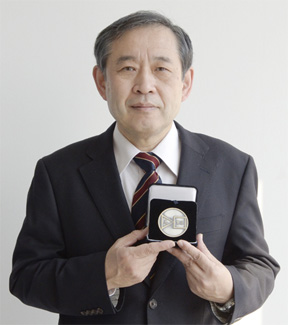Tuesday, April 5th, 2011
The Japanese Society of Applied Physics announced that lithography pioneer Prof. Masato Shibuya of the Tokyo Institute of Polytechnics would receive the 2011 ‘Outstanding Optical and Quantum Electronics Achievement Award’ for his invention of the Phase Shifting mask and other contributions to semiconductor manufacturing. This JSAP Outstanding Achievement Award is also called the Takuma Award to honor the late Hiroshi Takuma, one of the leaders of the laser community in Japan. The presentation to Shibuya was scheduled to be made at the 2011 International Conference of the JSAP that was to be held at the Kanagawa Institute of Technology during March 24-27 of this year, but was postponed because of the recent catastrophes.
Dr. Shibuya is little known in the United States, but well recognized in Japan as the originator of many of the technologies that have so advanced optical lithography. As he recounts it, he had not studied optics deeply at university but found himself in an optical design department at Nikon in 1977. While working on early automatic lens design software (which became popular internally), he realized that the textbook formulations were not adequate for Nikon’s purposes and decided to re-derive partially coherent imaging from scratch.
Working out specific examples led to the realization that something had been left out in the standard analysis, and that controlling the phase shifts between features at the mask (or the angles of off axis illumination) in a stepper could improve resolution, depth of focus (DoF), etc. That realization led to the famous Shibuya Patent, filed in September 1980 and published (in Japanese) in April 1982. “Honestly speaking, if I were more knowledgeable, I would not have been able to get the idea,” Shibuya wrote in a memoir published in Japan.
The same idea had occurred to this author while at IBM in 1982, doing work to be published but not to obtain a patent. In 1984, Shibuya visited Fairchild Semiconductor in South San Jose, where he learned about this work at IBM (roughly one mile away) but maintained his low profile. The idea of phase-shift at the mask was later extended by Hasegawa of Hitachi and Lin of IBM into the attenuating or half-tone phase-shifting mask, which required new semi-transparent materials.
By breaking out of the “what you see is what you get” layout paradigm, Shibuya’s idea enables today’s essential resolution enhancement technologies, including optical proximity correction (OPC), sub resolution assist features (SRAFs) and source-mask optimization (SMO). Shibuya took a different route, helping Nikon to develop its laser illumination systems. After Nikon he became a professor at the Tokyo Institute of Polytechnics, published the two textbooks “Optical Diffraction and Imaging” and “Introduction to Lens Optics,” and continued to work on optical and lithography innovations. –M.D.L.
Tags: Advanced Lithography, fab, IC, JSAP, Levenson, litho, mask, OAI, OPC, PSM, RET, Shibuya, SMO, SRAF, Takuma

